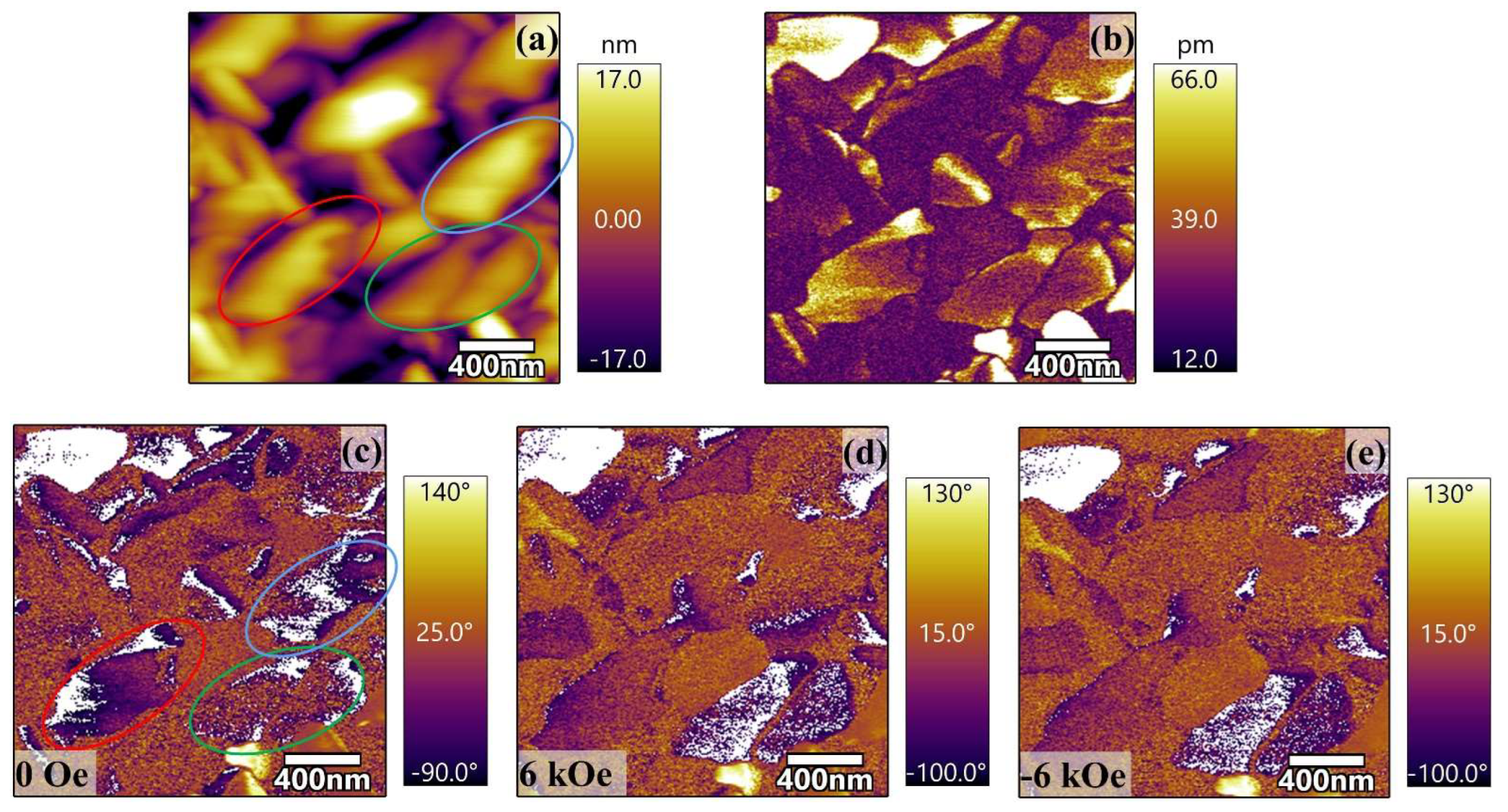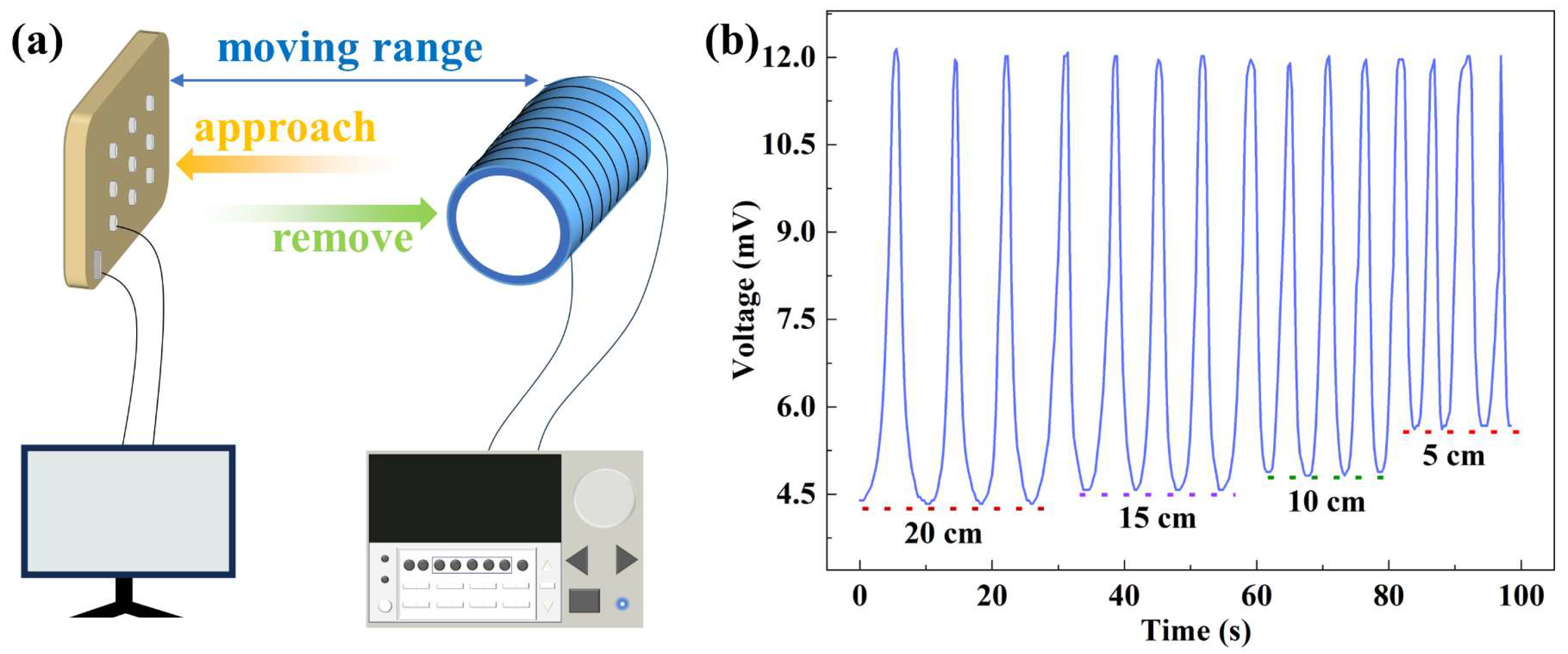A Flexible Magnetic Field Sensor Based on PZT/CFO Bilayer via van der Waals Oxide Heteroepitaxy
Abstract
:1. Introduction
2. Materials and Methods
3. Results
4. Conclusions
Author Contributions
Funding
Institutional Review Board Statement
Informed Consent Statement
Data Availability Statement
Conflicts of Interest
References
- Yang, N.; Wu, H.; Wang, S.; Yuan, G.; Zhang, J.; Sokolov, O.; Bichurin, M.I.; Wang, K.; Wang, Y. Ultrasensitive Flexible Magnetoelectric Sensor. APL Mater. 2021, 9, 021123. [Google Scholar] [CrossRef]
- Kumar, A.; Kaur, D. Magnetoelectric Heterostructures for Next-Generation MEMS Magnetic Field Sensing Applications. J. Alloys Compd. 2022, 897, 163091. [Google Scholar] [CrossRef]
- Dong, C.; Liang, X.; Gao, J.; Chen, H.; He, Y.; Wei, Y.; Zaeimbashi, M.; Matyushov, A.; Sun, C.; Sun, N.X. Thin Film Magnetoelectric Sensors Toward Biomagnetism: Materials, Devices, and Applications. Adv. Elect Mater. 2022, 8, 2200013. [Google Scholar] [CrossRef]
- Hu, J.-M.; Nan, C.-W. Opportunities and Challenges for Magnetoelectric Devices. APL Mater. 2019, 7, 080905. [Google Scholar] [CrossRef]
- Leontiev, V.S.; Lobekin, V.N.; Saplev, A.F.; Zueva, E.A.; Ivasheva, E.E.; Bichurin, M.I. Application of Magnetoelectric Sensors in Biomedicine. J. Phys. Conf. Ser. 2021, 2052, 012022. [Google Scholar] [CrossRef]
- Fernandes, M.M.; Martins, P.; Correia, D.M.; Carvalho, E.O.; Gama, F.M.; Vazquez, M.; Bran, C.; Lanceros-Mendez, S. Magnetoelectric Polymer-Based Nanocomposites with Magnetically Controlled Antimicrobial Activity. ACS Appl. Bio Mater. 2021, 4, 559–570. [Google Scholar] [CrossRef]
- Rodzinski, A.; Guduru, R.; Liang, P.; Hadjikhani, A.; Stewart, T.; Stimphil, E.; Runowicz, C.; Cote, R.; Altman, N.; Datar, R.; et al. Targeted and Controlled Anticancer Drug Delivery and Release with Magnetoelectric Nanoparticles. Sci. Rep. 2016, 6, 20867. [Google Scholar] [CrossRef]
- Li, J.; Sun, K.; Jin, Z.; Li, Y.; Zhou, A.; Huang, Y.; Yang, S.; Wang, C.; Xu, J.; Zhao, G.; et al. A Working-Point Perturbation Method for the Magnetoelectric Sensor to Measure DC to Ultralow-Frequency-AC Weak Magnetic Fields Simultaneously. AIP Adv. 2021, 11, 065213. [Google Scholar] [CrossRef]
- Li, J.; Ma, G.; Zhang, S.; Wang, C.; Jin, Z.; Zong, W.; Zhao, G.; Wang, X.; Xu, J.; Cao, D.; et al. AC/DC Dual-Mode Magnetoelectric Sensor with High Magnetic Field Resolution and Broad Operating Bandwidth. AIP Adv. 2021, 11, 045015. [Google Scholar] [CrossRef]
- Andrew, J.S.; Starr, J.D.; Budi, M.A.K. Prospects for Nanostructured Multiferroic Composite Materials. Scr. Mater. 2014, 74, 38–43. [Google Scholar] [CrossRef]
- Channagoudra, G.; Dayal, V. Magnetoelectric Coupling in Ferromagnetic/Ferroelectric Heterostructures: A Survey and Perspective. J. Alloys Compd. 2022, 928, 167181. [Google Scholar] [CrossRef]
- Palneedi, H.; Annapureddy, V.; Priya, S.; Ryu, J. Status and Perspectives of Multiferroic Magnetoelectric Composite Materials and Applications. Actuators 2016, 5, 9. [Google Scholar] [CrossRef]
- Fu, B.; Lu, R.; Gao, K.; Yang, Y.; Wang, Y. Substrate Clamping Effect onto Magnetoelectric Coupling in Multiferroic BaTiO3-CoFe2O4 Core-Shell Nanofibers via Coaxial Electrospinning. EPL 2015, 112, 27002. [Google Scholar] [CrossRef]
- Tian, Z.; Kim, J.; Fernandez, A.; Huang, X.; Martin, L.W. Effect of Substrate Clamping on Evolution of Properties in Homovalent and Heterovalent Relaxor Thin Films. Phys. Rev. B 2022, 105, 094107. [Google Scholar] [CrossRef]
- Kim, M.; Kim, D.; Aktas, B.; Choi, H.; Puigmartí-Luis, J.; Nelson, B.J.; Pané, S.; Chen, X. Strain-Sensitive Flexible Magnetoe-lectric Ceramic Nanocomposites. Adv. Mater. Technol. 2023, 8, 2202097. [Google Scholar] [CrossRef]
- Salles, P.; Guzmán, R.; Zanders, D.; Quintana, A.; Fina, I.; Sánchez, F.; Zhou, W.; Devi, A.; Coll, M. Bendable Polycrystalline and Magnetic CoFe2O4 Membranes by Chemical Methods. ACS Appl. Mater. Interfaces 2022, 14, 12845–12854. [Google Scholar] [CrossRef]
- Tsikriteas, Z.M.; Roscow, J.I.; Bowen, C.R.; Khanbareh, H. Flexible Ferroelectric Wearable Devices for Medical Applications. iScience 2021, 24, 101987. [Google Scholar] [CrossRef]
- Khan, Y.; Ostfeld, A.E.; Lochner, C.M.; Pierre, A.; Arias, A.C. Monitoring of Vital Signs with Flexible and Wearable Medical Devices. Adv. Mater. 2016, 28, 4373–4395. [Google Scholar] [CrossRef]
- Hashemi, S.A.; Ramakrishna, S.; Aberle, A.G. Recent Progress in Flexible–Wearable Solar Cells for Self-Powered Electronic Devices. Energy Environ. Sci. 2020, 13, 685–743. [Google Scholar] [CrossRef]
- Takei, K.; Honda, W.; Harada, S.; Arie, T.; Akita, S. Toward Flexible and Wearable Human-Interactive Health-Monitoring Devices. Adv. Healthc. Mater. 2015, 4, 487–500. [Google Scholar] [CrossRef]
- Liu, Y.; Song, S.; Gong, P.; Xu, L.; Li, K.; Li, D.; Wang, H.; Fan, J.; Qiu, L.; Tang, X.; et al. Flexible Ferroelectric Pb(Zr0.53Ti0.47)O3 Epitaxial Films with Large Radiation and High-Temperature Tolerance. Appl. Phys. Lett. 2022, 121, 122902. [Google Scholar] [CrossRef]
- Hu, L.; Sun, X.; Zhou, F.; Qi, J.; Wang, A.; Wang, C.; Liu, M.; Feng, M. Magnetic Coupling Modulation of Flexible Fe3O4/CoFe2O4 Heterojunction Grown on Mica. Ceram. Int. 2021, 47, 2672–2677. [Google Scholar] [CrossRef]
- Amrillah, T.; Hermawan, A.; Yin, S.; Juang, J.-Y. Formation and Physical Properties of the Self-Assembled BFO–CFO Vertically Aligned Nanocomposite on a CFO-Buffered Two-Dimensional Flexible Mica Substrate. RSC Adv. 2021, 11, 15539–15545. [Google Scholar] [CrossRef] [PubMed]
- Liu, J.; Feng, Y.; Tang, R.; Zhao, R.; Gao, J.; Shi, D.; Yang, H. Mechanically Tunable Magnetic Properties of Flexible SrRuO3 Epitaxial Thin Films on Mica Substrates. Adv. Elect. Mater. 2018, 4, 1700522. [Google Scholar] [CrossRef]
- Xu, R.; Zhang, X.; Zhang, D.; Liu, J.; Lu, J.; Zhao, R.; Ji, Y.; Qian, F.; Wang, H.; Fan, J.; et al. High Stability of Flexible Perovskite Transparent Conductive Oxide Film via van Der Waals Heteroepitaxy. J. Alloys Compd. 2022, 890, 161897. [Google Scholar] [CrossRef]
- Jana, B.; Ghosh, K.; Rudrapal, K.; Gaur, P.; Shihabudeen, P.K.; Roy Chaudhuri, A. Recent Progress in Flexible Multiferroics. Front. Phys. 2022, 9, 822005. [Google Scholar] [CrossRef]
- Zhang, T.; Yao, G.; Pan, T.; Lu, Q.; Lin, Y. Flexible Inorganic Oxide Thin-Film Electronics Enabled by Advanced Strategies. J. Semicond. 2020, 41, 041602. [Google Scholar] [CrossRef]
- Zhang, D.; Schoenherr, P.; Sharma, P.; Seidel, J. Ferroelectric Order in van Der Waals Layered Materials. Nat. Rev. Mater. 2022, 8, 25–40. [Google Scholar] [CrossRef]
- Amrillah, T.; Bitla, Y.; Shin, K.; Yang, T.; Hsieh, Y.-H.; Chiou, Y.-Y.; Liu, H.-J.; Do, T.H.; Su, D.; Chen, Y.-C.; et al. Flexible Multiferroic Bulk Heterojunction with Giant Magnetoelectric Coupling via van Der Waals Epitaxy. ACS Nano 2017, 11, 6122–6130. [Google Scholar] [CrossRef]
- Utama, M.I.B.; Belarre, F.J.; Magen, C.; Peng, B.; Arbiol, J.; Xiong, Q. Incommensurate van Der Waals Epitaxy of Nanowire Arrays: A Case Study with ZnO on Muscovite Mica Substrates. Nano Lett. 2012, 12, 2146–2152. [Google Scholar] [CrossRef]
- Manjula Devi, M.; Anand, A.; Veena, R.K.; Veena, V.S.; Nandakumar, K.; Sagar, S. Dielectric and Magnetoelectric Coupling Properties of Lead-Free (1−x)Bi0.9Sm0.1FeO3/(x)La0.7Sr0.3MnO3 (x = 0, 0.05, 0.1) Composites at Room Temperature. Mater. Today Proc. 2021, 47, 1755–1759. [Google Scholar] [CrossRef]
- Channagoudra, G.; Saw, A.K.; Dey, K.; Xavier, D.; Venkatesh, R.; Subramanian, V.; Shukla, D.K.; Dayal, V. Substantial Magnetoelectric Response in 2/3[Pb(Mg1/3Nb2/3)O3]−1/3[PbTiO3]-CoFe2O4 Composites. J. Alloys Compd. 2021, 863, 158504. [Google Scholar] [CrossRef]
- Koner, S.; Deshmukh, P.; Ahlawat, A.; Karnal, A.K.; Satapathy, S. Studies on Structural, Dielectric, Impedance Spectroscopy and Magneto-Dielectric Properties of La0.7Ba0.3MnO3/P(VDF-TrFE) Multiferroic (0–3) Nanocomposite Films. J. Alloys Compd. 2021, 868, 159104. [Google Scholar] [CrossRef]
- Bajac, B.; Vukmirovic, J.; Samardzic, N.; Banys, J.; Stojanovic, G.; Bobic, J.; Srdic, V.V. Dielectric and Ferroelectric Properties of Multilayer BaTiO3/NiFe2O4 Thin Films Prepared by Solution Deposition Technique. Ceram. Int. 2022, 48, 26378–26386. [Google Scholar] [CrossRef]
- Huamán, J.L.C.; Rivera, V.A.G.; Pinto, A.H.; Marega, E. Multiferroic Perovskite Ceramics: Properties and Applications. In Perovskite Ceramics; Elsevier: Amsterdam, The Netherlands, 2023; pp. 339–381. [Google Scholar]
- Simoes, A.Z.; Ortega, P.P.; Ramirez, M.A.; Moreno, H.; Aldao, C.M.; Ponce, M.A.; Moura, F. Magnetoelectric Coupling at Room Temperature in LaTiO3/SrTiO3 Heterojunctions. Mater. Res. Bull. 2023, 162, 112169. [Google Scholar] [CrossRef]
- Shirsath, S.E.; Cazorla, C.; Lu, T.; Zhang, L.; Tay, Y.Y.; Lou, X.; Liu, Y.; Li, S.; Wang, D. Interface-Charge Induced Giant Elec-trocaloric Effect in Lead Free Ferroelectric Thin-Film Bilayers. Nano Lett. 2020, 20, 1262–1271. [Google Scholar] [CrossRef]
- Song, C.; Guo, K.; Wang, X.; Cui, R.; Deng, C. Multiferroic Magnetoelectric Coupling Effect of Three-Layer Multiferroic (Ba0.6Sr0.4TiO3–Ni0.6Zn0.4Fe2O4)3 Heterojunction Fabricated by Sol–Gel Process. J. Mater. Sci. Mater. Electron. 2021, 32, 20177–20183. [Google Scholar] [CrossRef]
- Zhai, J.; Dong, S.; Xing, Z.; Li, J.; Viehland, D. Giant Magnetoelectric Effect in Metglas/Polyvinylidene-Fluoride Laminates. Appl. Phys. Lett. 2014, 96, 3382. [Google Scholar] [CrossRef]
- Yu, A.; Song, M.; Zhang, Y.; Kou, J.; Zhai, J.; Lin Wang, Z. A Self-Powered AC Magnetic Sensor Based on Piezoelectric Nan-ogenerator. Nanotechnology 2014, 25, 455503. [Google Scholar] [CrossRef]
- Reis, S.; Silva, M.P.; Castro, N.; Correia, V.; Martins, P.; Lasheras, A.; Gutierrez, J.; Barandiarán, J.M.; Rocha, J.G.; Lanceros-Mendez, S. Characterization of Metglas/Poly(Vinylidene Fluoride)/Metglas Magnetoelectric Laminates for AC/DC Magnetic Sen-sor Applications. Mater. Des. 2016, 92, 906–910. [Google Scholar] [CrossRef]
- Wang, Z.; Wang, X.; Li, M.; Gao, Y.; Hu, Z.; Nan, T.; Liang, X.; Chen, H.; Yang, J.; Cash, S.; et al. Highly Sensitive Flexible Magnetic Sensor Based on Anisotropic Magnetoresistance Effect. Adv. Mater. 2016, 28, 9370–9377. [Google Scholar] [CrossRef] [PubMed]
- Zang, Y.; Zhang, F.; Huang, D.; Di, C.; Zhu, D. Sensitive Flexible Magnetic Sensors Using Organic Transistors with Magnetic-Functionalized Suspended Gate Electrodes. Adv. Mater. 2015, 27, 7979–7985. [Google Scholar] [CrossRef] [PubMed]
- Suo, Z.; Ma, E.Y.; Gleskova, H.; Wagner, S. Mechanics of Rollable and Foldable Film-on-Foil Electronics. Appl. Phys. Lett. 1999, 74, 1177–1179. [Google Scholar] [CrossRef]







| Composition/Materials | AC/DC | Limit of Detection | Ref |
|---|---|---|---|
| Metglas/PVDF | AC | 10 pT | [39] |
| ZnO | AC | 120 nT | [40] |
| Pb(Zr0.52Ti0.48)O3/Metglas | AC | 0.2 nT | [1] |
| Metglas/PVDF/Metglas | AC | 8 nT | [41] |
| Ni0.81Fe0.19/PR/PET | AC | 150 nT | [42] |
| Pb(Zr0.20Ti0.80)O3/CoFe2O4 | AC | 5 nT | This work |
| AgNWs/PDMS/Fe3O4 | DC | 0.5 mT | [43] |
| Metglas/PVDF | DC | 8 nT | [39] |
| Metglas/PVDF/Metglas | DC | 8 nT | [41] |
| Pb(Zr0.20Ti0.80)O3/CoFe2O4 | DC | 5 mT | This work |
| Bending Radius (mm) | Sensitivity (mV/Oe) | Linearity |
|---|---|---|
| Flat | 72.654 | 0.9988 |
| Flex-out 20 | 72.253 | 0.9986 |
| Flex-out 15 | 62.125 | 0.9980 |
| Flex-out 10 | 44.398 | 0.9986 |
| Flex-out 5 | 36.302 | 0.9987 |
| Flex-in 20 | 71.990 | 0.9987 |
| Flex-in 15 | 63.244 | 0.9987 |
| Flex-in 10 | 44.698 | 0.9985 |
| Flex-in 5 | 37.031 | 0.9986 |
Disclaimer/Publisher’s Note: The statements, opinions and data contained in all publications are solely those of the individual author(s) and contributor(s) and not of MDPI and/or the editor(s). MDPI and/or the editor(s) disclaim responsibility for any injury to people or property resulting from any ideas, methods, instructions or products referred to in the content. |
© 2023 by the authors. Licensee MDPI, Basel, Switzerland. This article is an open access article distributed under the terms and conditions of the Creative Commons Attribution (CC BY) license (https://creativecommons.org/licenses/by/4.0/).
Share and Cite
Pan, W.; Ao, Y.; Zhou, P.; Fetisov, L.; Fetisov, Y.; Zhang, T.; Qi, Y. A Flexible Magnetic Field Sensor Based on PZT/CFO Bilayer via van der Waals Oxide Heteroepitaxy. Sensors 2023, 23, 9147. https://doi.org/10.3390/s23229147
Pan W, Ao Y, Zhou P, Fetisov L, Fetisov Y, Zhang T, Qi Y. A Flexible Magnetic Field Sensor Based on PZT/CFO Bilayer via van der Waals Oxide Heteroepitaxy. Sensors. 2023; 23(22):9147. https://doi.org/10.3390/s23229147
Chicago/Turabian StylePan, Weijuan, Yuan Ao, Peng Zhou, Leonid Fetisov, Yuri Fetisov, Tianjin Zhang, and Yajun Qi. 2023. "A Flexible Magnetic Field Sensor Based on PZT/CFO Bilayer via van der Waals Oxide Heteroepitaxy" Sensors 23, no. 22: 9147. https://doi.org/10.3390/s23229147
APA StylePan, W., Ao, Y., Zhou, P., Fetisov, L., Fetisov, Y., Zhang, T., & Qi, Y. (2023). A Flexible Magnetic Field Sensor Based on PZT/CFO Bilayer via van der Waals Oxide Heteroepitaxy. Sensors, 23(22), 9147. https://doi.org/10.3390/s23229147





